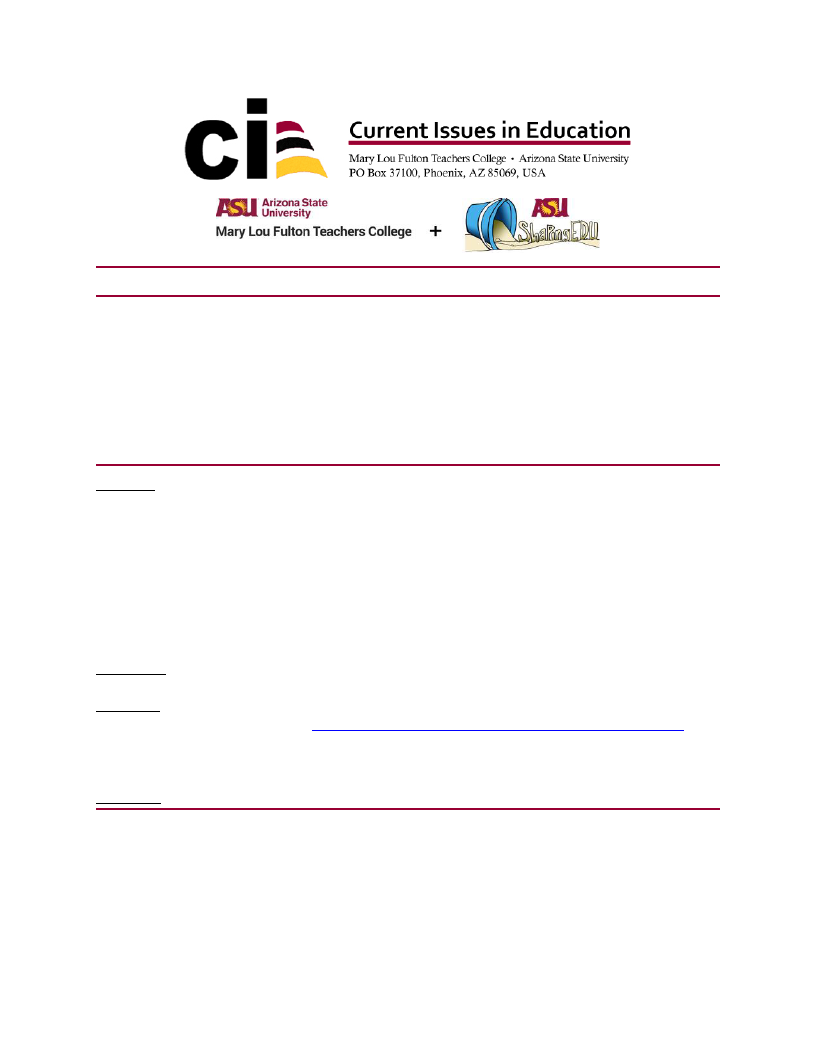
Volume 22, Issue 1
January 7, 2021
ISSN 1099-839X
Shaping the Futures of Learning in the Digital Age
The Digitization of White Women’s Tears
Niki Messmore
Indiana University
Abstract: Social media is a digital mirror of society. Across disciplines, scholars have written of
social justice as it exists and as it should be within higher education and beyond. Looking to social
media spaces where higher education practitioners and scholars interact with one another, we can
see how scholars who discuss social justice initiatives can themselves perpetuate systems of
oppression. Utilizing Mamta Motwani Accapadi’s (2007) article “When White Women Cry: How
White Women's Tears Oppress Women of Color” as a foundation, I reflect through poetry on how
white women in positions of power within higher education engage in harmful behavior in digital
spaces. Finally, I provide recommendations on how fellow white women can disrupt these acts of
oppression.
Keywords: Race, Social Media, Whiteness, Gender
Citation: Messmore, N. (2021). The digitization of white women’s tears. Current Issues in
Education, 21(2). Retrieved from http://cie.asu.edu/ojs/index.php/cieatasu/article/view/1908 This
submission is part of a special issue, Shaping the Futures of Learning in the Digital Age, guest-
edited by Sean Leahy, Samantha Becker, Ben Scragg, and Kim Flintoff.
Accepted: October/27/2020
The Digitization of White Women’s Tears
Current Issues in Education, 22(1)
1

Messmore: The Digitization of White Women’s Tears
Mamta Accapadi told us in 20071
The power, the fragility
Of White Women’s Tears
Mamta Accapadi told us
About “One up, One Down”
White women always thinking they’re “down”
When that reality is disrupted?
They cry a river
Their whiteness a raft
Carrying them downstream
Far from judgement
But on social media?
Minoritized folks share their voice
In a way they can’t always at work
In the digital space there is power
In the digital space there is voice
In the digital space…
There’s still white woman’s tears.
We keep seeing it in higher ed
These white women with 3 letter acronyms
C. R. Y.
They take issue with a meme
Because they got time in an 80-hour work week
Because they got time to misgender folks
They call folks a dumpster fire
Because folks talk about oppression at work
Because folks aren’t shiny happy people
Because folks aren’t
Cis, White, Nondisabled
Content with the status quo
Call them out?
Call them in?
1 For more information on this reference, review Dr. Accapadi’s 2007 article “When White Women Cry: How White
Women's Tears Oppress Women of Color”.
Current Issues in Education, 21(2)
2

Messmore: The Digitization of White Women’s Tears
Watch the digitization of white women’s tears
Pie is delicious
But the P.I.E. defense mechanisms?2
Leaves a bitter taste
The bitterness of
“The Black List”
Threatening that these minoritized folks won’t get hired
The bitterness of
Their privilege of legal teams
Threatening a lawsuit
Online or off
White Women’s Tears
Are a protective force (for them)(for us)
But what can we do?
We white women?
How do we hold our people accountable?
How do we hold ourselves accountable?
We retweet
(online and off)
Folks of color and their critiques
We dam their white women tears
We talk to them
We teach
We visibly interrupt their acts of oppression
We make it known that it is unacceptable
If there’s a Black List? They’re on it
We can’t let
White Women’s Tears
Keep drowning folks
2 For more information on this reference, please review Dr. Watt’s 2007 article “Difficult Dialogues, Privilege and
Social Justice: Uses of the Privileged Identity Exploration (PIE) Model in Student Affairs Practice.”
Current Issues in Education, 21(2)
3

Messmore: The Digitization of White Women’s Tears
References
Accapadi, M. M. (2007). When white women cry: How white women's tears oppress
women of color. College Student Affairs Journal, 26(2), 208-215.
Watt, S. K. (2007). Difficult dialogues, privilege and social justice: Uses of the privileged
identity exploration (PIE) model in student affairs practice. College Student Affairs
Journal, 26(2), 114-126.
Niki Messmore
Indiana University
nmmessmo@iupui.edu
Author Notes
Guest Editor Notes
Sean M. Leahy, PhD
Arizona State University, Director of Technology Initiatives
sean.m.leahy@asu.edu
Samantha Adams Becker
Arizona State University, Executive Director, Creative & Communications, University
Technology Office; Community Director, ShapingEDU
sam.becker@asu.edu
Ben Scragg, MA, MBA
Arizona State University, Director of Design Initiatives
bscragg@asu.edu
Kim Flintoff
Peter Carnley ACS, TIDES Coordinator
kflintoff@pcacs.wa.edu.au
Current Issues in Education, 21(2)
4

Messmore: The Digitization of White Women’s Tears
Volume 22, Issue 1
January 7, 2021
ISSN 1099-839X
Readers are free to copy, display, and distribute this article, as long as the work is attributed to the
author(s) and Current Issues in Education (CIE), it is distributed for non-commercial purposes only, and no alteration
or transformation is made in the work. More details of this Creative Commons license are available at
http://creativecommons.org/licenses/by-nc-sa/3.0/. All other uses must be approved by the author(s) or CIE. Requests
to reprint CIE articles in other journals should be addressed to the author. Reprints should credit CIE as the original
publisher and include the URL of the CIE publication. CIE is published by the Mary Lou Fulton Teachers College at
Arizona State University.
Editorial Team
Consulting Editor
Neelakshi Tewari
Lead Editor
Marina Basu
Section Editors
L&I – Renee Bhatti-Klug
LLT – Anani Vasquez
EPE – Ivonne Lujano Vilchis
Review Board
Blair Stamper
Melissa Warr
Monica Kessel
Helene Shapiro
Sarah Salinas
Faculty Advisors
Josephine Marsh
Leigh Wolf
Current Issues in Education, 21(2)
5
